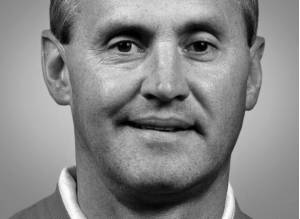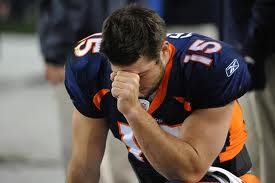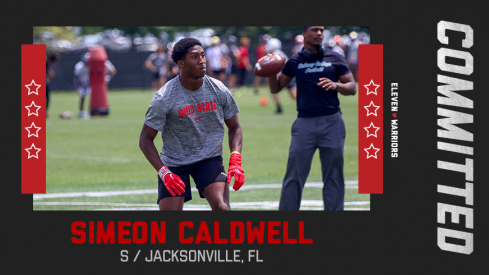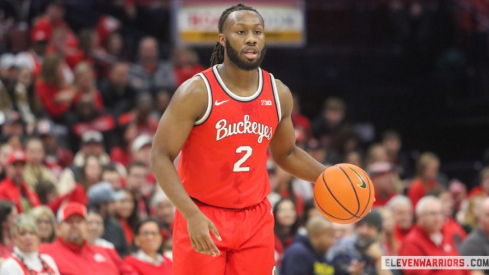Ohio State adds another top-100 safety as Simeon Caldwell commits to the Buckeyes.
 This man lied | no one died | his carcass was delicious.
This man lied | no one died | his carcass was delicious.The manner in which the media breathlessly caressed and inflated Ohio State's miserable 2011 with all of the journalistic credibility of a hair salon is a well-beaten discussion path amongst frustrated Buckeye fans.
When the NCAA's final report contained only a fraction of the bad news that had been reported as fact for months, this created a false perception that Ohio State was handled with kid gloves by the COI. (Search for the words Dennis Talbott, free cars, television ban or endorsed checks amounting to $20-$40K for super secret autograph sessions in the NCAA's final report. Surprised? Disappointed?)
While the bias has been tossed around for years, what's never been clear regarding the disproportionate coverage and intertwining of facts with pure speculation is how or why Ohio State earned that bulls-eye from the media behemoth. It's driving a lot of you crazy. Thanks for all the cards and letters, by the way.
ESPN, which has had a noticeable hard-on for the Buckeyes dating back to its odd three-year obsession with Maurice Clarett, is still - curiously - suing the university to see documents the NCAA already accessed and considered in issuing its final judgment to what is now a closed case.
There are no accidents in news coverage, and because they hate us borders on unhinged paranoia, so initial theories on ESPN's Buckeye fetish were focused on the Big Ten Network and its content as a direct ESPN competitor: Inflict damage on one of its marquee content providers and you hurt BTN via communicative shrapnel. As with everything else, it was because of money.
But then the Jerry Sandusky tragedy unfolded at Penn State and ESPN's coverage was sluggish from the outset; almost hesitant to devote resources to covering the story, as if it was Ben Roethlisberger's rape case (billions invested in the NFL!) Jim Calhoun's major violations at UConn (he tapes Sportscenter commercials!) the Willie Lyles/Chip Kelly story (he tapes Sportscenter commercials!) or the Nevin Shapiro scandal at Miami that ESPN explicitly refused to acknowledge until it became too awkward to ignore it any longer.
Until Sandusky and the Penn State administration provided the most horrendous measuring stick imaginable, Tressel's cover-up was the scandal of the year in American sports - not because of what transpired, but mainly because of how the media - ESPN, mostly - chose to shape the narrative of a man who was caught and turned in for lying by his employer.
If all such cases were handled with the same sensationalism, it would be easy to chalk it up to the nature of the business. That is far from reality: The disparity in coverage for scandals is as wide as the stories are distorted.
Why did ESPN sit on the Bernie Fine tapes for eight years? Why did the media at large deliberately avoid applying scrutiny to the Cam Newton case at Auburn? (And after you peruse the letters in that Deadspin link to Auburn from actual, credentialed journalists - how many favors did Joe Schad's father cash in to get junior his dream job in sports media?)
The only conceivable way you would hear anything of substance about the Miami or Oregon investigations on ESPN would be if Tim Tebow happened to mention them. Distortion and selective reporting are not monopolized exclusively by bad news. There's money in making people feel good too.
By comparison to the hands-off approach taken with those other scandals, ESPN requested so much information from Ohio State about the Tressel investigation it was willing to pay up to $500 in photocopying and postage fees to capture it all. When it did not get everything it wanted, that lawsuit happened.
Obsession isn't free or cheap, and neither are legal services. ESPN pursued the story, and chronicled its pursuit all along the way. If it is in the process of doing so either with Miami or Oregon, it's doing so silently.
Several readers have asked me about documenting cases of bias against Ohio State in some sort of Media Matters-type of operation. I'm not sold on how healthy or useful that would be. A cathartic us-against-the-world circle jerk by any other name is still just a circle jerk. There's no peace in understanding, at least not in these parts. Taking on the media on behalf of a single football program would make David vs. Goliath look like a pick'em game in Vegas.
Last summer as Ohio State's carcass was simmering in the media cauldron because its football coach hid petty cash violations from the NCAA and played those petty cash-recipients in games, I landed on Ohio State's popularity as the reason it consistently floated to the top of the bad news fishbowl. If Ohio State was, say, Central Florida - whose current LOI dwarfs anything else the NCAA reviewed in 2011 - it would have been a passing story.
News and ratings have become inextricably attached, and it extends beyond sports: Cable news has long repackaged nearly all of its reporting as breaking news, regardless of whether it was breaking or news at all.
ESPN, with billions invested in the NFL, started with character-driven pieces to engage and attract viewers (Favre!) and slowly morphed those pieces into news items (Tebow!) until the manufactured promotions themselves became the actual news stories. No one is more meta than ESPN.
If there's bad news - or the NFL doesn't approve of content that might cause the league to be viewed in an unfavorable light - that content is eliminated. It's essentially state-sponsored media. We still love it. It's football.
The byproduct of how the news is shaping is not solely elevated ratings and increased product promotion; it also significantly impacts perception. When Ohio State "escaped" the penalties it truly deserved, ESPN immediately began pushing an ill-begotten comparison to USC's punishment.
The OSU/USC angle taken by ESPN was fascinating, since not a single one reporter at ESPN ever bothered to cover or discuss the NCAA's multi-year investigation into Reggie Bush or Todd McNair during the years that it was taking place. ESPN must have hastily constructed a summary of the USC case before deploying that talk track across its television, Internet and radio platforms simultaneously. The Wikipedia machine in Bristol had to be running hot in December.
[READER CHALLENGE: The first 11W user who can produce any original ESPN story on the Reggie Bush/USC scandal and NCAA investigation dated between 9/15/2006 when Yahoo! Sports broke the story and 6/9/2010 when the NCAA's verdict arrived will receive the shirt of her/his choosing from the 11W Dry Goods Depot. This should be as easy as folding the same piece of paper in half nine times]
The OSU and USC cases and investigations were in no way similar, but details are boring while black-and-white dichotomies are not only more interesting but easier to sell. The simplest conclusion that can be taken from ESPN's willful ignorance toward the USC investigation - and Miami's, for that matter - is that Yahoo! Sports owned the attribution. Acknowledging competitors is too humbling of a burden for the Worldwide Leader, even it if means diminishing the value of your own news division.
Credentialed reporters routinely allow their biases to pollute their reporting, but that's a practice that transcends ESPN. When CBS Sports' Dennis Dodd referred to Tressel's final bi-weekly paycheck a "golden parachute" there were outraged people who actually believed that .033% of a now-terminated contract was hush money. Math like that isn't that difficult, but sanctimonious bullshit requires no talent at all - and it commands attention.
 "They said I couldn't become a colloquial verb in America."
"They said I couldn't become a colloquial verb in America."One thing that Freedom of Information Requests cannot uncover is why news rooms selectively choose the stories they beat to death with an exploitation stick, versus the ones they wrinkle their noses at and leave alone.
There may have been a time when journalists could remove their biases to approach and prioritize stories without bias, but that era is not this one. When information dissemination and entertainment collide, there are emotions that end up shaping what we perceive as the facts.
Journalists are not robots that calculate the worthiness of a story prior to determining how important it is. They're humans who sit in production meetings and agree with each others' ideas, support each others' projects and enable content chasers to successfully capture personal glory. It's not always about the story. Often times it's about the reporter; be it her career or his personal biases.
The best recent example was the audible groan that was let out by the press corps and the subsequent berating of the PSU Board of Trustees during the press conference when it announced that Paterno had fired.
This is the same press corps that for decades had a hand in constructing Paterno's image as one of college football's saints. Consider what impact that may have had on the Paterno narrative over his decades in State College. That's not to question his powerful and positive legacy beyond his multi-year failure to adequately or purposefully expose Sandusky, but it could have contributed to the culture of protectionism that subsequently shattered his university.
Shelving bias on a personal level is challenge for any writer. When that compartmentalization fails on a local level, you get the State College press corps the night Paterno was fired. When it fails at the largest level, you get ESPN on a daily basis, juggling independent biases and enormous conflicts of interest in deciding what qualifies as news.
It's routinely said that college football is a cesspool; the odor of which is obscured only by how captivating the game is. The college football media is rife with full-grown, credentialed fan boys who pick and choose how to shape the news. It smells just as bad. College football carries emotions that were planted in childhood for most of its fans.
Speaking from personal experience, writing stories that challenge your loyalties is no fun at all, and neither is scrutinizing your beloved program, but it comes with the territory. At least it is supposed to.
On Sunday morning when Paterno succumbed to cancer, the first college football coach ESPN retained to impart his thoughts was Alabama's Nick Saban, whom it has also employed in the past for commentary, roundtables on "how to fix college football" and game analysis.
It was an odd choice, considering Saban left the Big Ten over a decade ago and has zero ties to Penn State, plus the fact that there are innumerable people closer to both the university and Paterno who could have easily been reached on an offseason Sunday morning.
But Saban - and Auburn's Gene Chizik, as well as (dramatic pause) Urban Meyer have pre-existing media relationships with ESPN. Saban would have been an odd choice for anyone but the network who contacted him first to provide his reflections on the passing of college football's winningest coach.
Could its business arrangement with the SEC impact how ESPN chooses to cover news that's potentially damaging to an SEC program? It's an n of one, but refer back to the Deadspin link that exposed how the Cam Newton story was summarily pushed off the national stage. Compare that to its pursuit of the truth in Ohio State's case convince yourself it was an anomaly.
As a fan invested in a team you unhealthily think about daily, it's healthy to assess those tertiary elements that out of your control and what they are worth to you. You cannot control or retrain it, but the manner in which news is shaped, molded and massaged is worth your frustration.
The joy and pain you derive from following it is worth your time. Understanding how and why stories are manipulated is worth your scrutiny. And ESPN's 15-year contract with the SEC is worth $3 billion.

